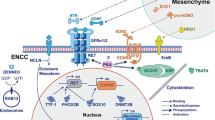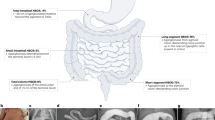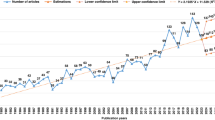Abstract
Hirschsprung's disease (HSCR) is a congenital disorder in which ganglion cells are absent in variable portions of the lower digestive tract according to which patients are classified. The RET gene is the major HSCR gene, although reduced penetrance of RET mutations and variable expression of HSCR phenotype indicates that more than one gene is required. An unidentified RET-dependent modifier on 3p21 appears to be necessary for transmission of the short HSCR (S-HSCR) phenotype. We investigated 6 Mb of the 3p21 region on a quest for the HSCR-susceptibility locus. Fifty-eight S-HSCR case–parent trios were genotyped using Sequenom technology for 214 tag single nucleotide polymorphisms (SNPs) distributed along 6 Mb of the 3p21 region. A five-marker haplotype, spanning a 118 kb gene-rich region, was found to be overtransmitted to affected offspring. The associated haplotype encompasses three genes involved in neurological phenotypes. Importantly, this association was replicated in an independent sample of 172 S-HSCR cases and 153 unrelated controls. Ranking markers by proximity to candidate genes or by expected functional consequences could be used in follow-up studies to finally pinpoint this HSCR locus.
Similar content being viewed by others
Log in or create a free account to read this content
Gain free access to this article, as well as selected content from this journal and more on nature.com
or
References
Amiel J, Lyonnet S : Hirschsprung disease, associated syndromes, and genetics: a review. J Med Genet 2001; 38: 729–739.
Torfs C : An epidemiological study of Hirschsprung' disease in a multiracial California population. Third International Meeting: Hirschsprung's disease and related neurocristophaties Evian, France 1998 2004.
Edery P, Lyonnet S, Mulligan LM et al: Mutations of the RET proto-oncogene in Hirschsprung's disease. Nature 1994; 367: 378–380.
Puffenberger EG, Kauffman ER, Bolk S et al: Identity-by-descent and association mapping of a recessive gene for Hirschsprung disease on human chromosome 13q22. Hum Mol Genet 1994; 3: 1217–1225.
Angrist M, Bolk S, Halushka M et al: Germline mutations in glial cell line-derived neurotrophic factor (GDNF) and RET in a Hirschsprung disease patient. Nat Genet 1996; 14: 341–344.
Hofstra RM, Valdenaire O, Arch E et al: A loss-of-function mutation in the endothelin-converting enzyme 1 (ECE-1) associated with Hirschsprung disease, cardiac defects, and autonomic dysfunction. Am J Hum Genet 1999; 64: 304–308.
Pingault V, Bondurand N, Kuhlbrodt K et al: SOX10 mutations in patients with Waardenburg-Hirschsprung disease. Nat Genet 1998; 18: 171–173.
Carrasquillo MM, McCallion AS, Puffenberger EG et al: Genome-wide association study and mouse model identify interaction between RET and EDNRB pathways in Hirschsprung disease. Nat Genet 2002; 32: 237–244.
McCallion AS, Stames E, Conlon RA et al: Phenotype variation in two-locus mouse models of Hirschsprung disease: tissue-specific interaction between Ret and Ednrb. Proc Natl Acad Sci USA 2003; 100: 1826–1831.
Lang D, Epstein JA : Sox10 and Pax3 physically interact to mediate activation of a conserved c-RET enhancer. Hum Mol Genet 2003; 12: 937–945.
Lang D, Chen F, Milewski R et al: Pax3 is required for enteric ganglia formation and functions with Sox10 to modulate expression of c-ret. J Clin Invest 2000; 106: 963–971.
Borrego S, Ruiz A, Saez ME et al: RET genotypes comprising specific haplotypes of polymorphic variants predispose to isolated Hirschsprung disease. J Med Genet 2000; 37: 572–578.
Sancandi M, Griseri P, Pesce B et al: Single nucleotide polymorphic alleles in the 5′ region of the RET proto-oncogene define a risk haplotype in Hirschsprung's disease. J Med Genet 2003; 40: 714–718.
Burzynski GM, Nolte IM, Osinga J et al: Localizing a putative mutation as the major contributor to the development of sporadic Hirschsprung disease to the RET genomic sequence between the promoter region and exon 2. Eur J Hum Genet 2004; 12: 604–612.
Garcia-Barcelo MM, Sham MH, Lui VC et al: Chinese patients with sporadic Hirschsprung's disease are predominantly represented by a single RET haplotype. J Med Genet 2003; 40: e122.
Garcia-Barcelo M, Ganster RW, Lui VC et al: TTF-1 and RET promoter SNPs: regulation of RET transcription in Hirschsprung's disease. Hum Mol Genet 2005; 14: 191–204.
Burzynski GM, Nolte IM, Bronda A et al: Identifying candidate Hirschsprung disease-associated RET variants. Am J Hum Genet 2005; 76: 850–858.
Fitze G, Cramer J, Serra A et al: Within-gene interaction between c.135 G/A genotypes and RET proto-oncogene germline mutations in HSCR families. Eur J Pediatr Surg 2003; 13: 152–157.
Fitze G, Cramer J, Ziegler A et al: Association between c135G/A genotype and RET proto-oncogene germline mutations and phenotype of Hirschsprung's disease. Lancet 2002; 359: 1200–1205.
Fitze G, Appelt H, Konig IR et al: Functional haplotypes of the RET proto-oncogene promoter are associated with Hirschsprung disease (HSCR). Hum Mol Genet 2003; 12: 3207–3214.
Emison ES, McCallion AS, Kashuk CS et al: A common sex-dependent mutation in a RET enhancer underlies Hirschsprung disease risk. Nature 2005; 434: 857–863.
Gabriel SB, Salomon R, Pelet A et al: Segregation at three loci explains familial and population risk in Hirschsprung disease. Nat Genet 2002; 31: 89–93.
The International HapMap consortium: A haplotype map of the human genome. Nature 2005; 437: 1299–1320.
Ao SI, Yip K, Ng M et al: CLUSTAG: hierarchical clustering and graph methods for selecting tag SNPs. Bioinformatics 2005; 21: 1735–1736.
Jurinke C, van den BD, Cantor CR et al: Automated genotyping using the DNA MassArray technology. Methods Mol Biol 2001; 170: 103–116.
Purcell S, Daly MJ, Sham PC : WHAP: haplotype-based association analysis. Bioinformatics 2007; 23: 255–256.
Barrett JC, Fry B, Maller J et al: Haploview: analysis and visualization of LD and haplotype maps. Bioinformatics 2005; 21: 263–265.
Abecasis GR, Cherny SS, Cookson WO et al: Merlin—rapid analysis of dense genetic maps using sparse gene flow trees. Nat Genet 2002; 30: 97–101.
Gabriel SB, Schaffner SF, Nguyen H et al: The structure of haplotype blocks in the human genome. Science 2002; 296: 2225–2229.
Heanue TA, Pachnis V : From the Cover: expression profiling the developing mammalian enteric nervous system identifies marker and candidate Hirschsprung disease genes. Proc Natl Acad Sci USA 2006; 103: 6919–6924.
Artigiani S, Comoglio PM, Tamagnone L : Plexins, semaphorins, and scatter factor receptors: a common root for cell guidance signals? IUBMB Life 1999; 48: 477–482.
Worzfeld T, Puschel AW, Offermanns S et al: Plexin-B family members demonstrate non-redundant expression patterns in the developing mouse nervous system: an anatomical basis for morphogenetic effects of Sema4D during development. Eur J Neurosci 2004; 19: 2622–2632.
Bolk S, Pelet A, Hofstra RM et al: A human model for multigenic inheritance: phenotypic expression in Hirschsprung disease requires both the RET gene and a new 9q31 locus. Proc Natl Acad Sci USA 2000; 97: 268–273.
Bourdon JC, Renzing J, Robertson PL et al: Scotin, a novel p53-inducible proapoptotic protein located in the ER and the nuclear membrane. J Cell Biol 2002; 158: 235–246.
Terrinoni A, Ranalli M, Cadot B et al: p73-alpha is capable of inducing scotin and ER stress. Oncogene 2004; 23: 3721–3725.
Rossi M, Sayan AE, Terrinoni A et al: Mechanism of induction of apoptosis by p73 and its relevance to neuroblastoma biology. Ann N Y Acad Sci 2004; 1028: 143–149.
Lantieri F, Griseri P, Ceccherini I : Molecular mechanisms of RET-induced Hirschsprung pathogenesis. Ann Med 2006; 38: 11–19.
Bordeaux MC, Forcet C, Granger L et al: The RET proto-oncogene induces apoptosis: a novel mechanism for Hirschsprung disease. EMBO J 2000; 19: 4056–4063.
Kapur RP : Early death of neural crest cells is responsible for total enteric aganglionosis in Sox10(Dom)/Sox10(Dom) mouse embryos. Pediatr Dev Pathol 1999; 2: 559–569.
Dubchak I, Ryaboy DV : VISTA family of computational tools for comparative analysis of DNA sequences and whole genomes. Methods Mol Biol 2006; 338: 69–89.
Acknowledgements
We thank all subjects who participated in the study. This work was supported by research Grants HKU 765407M and HKU 775907M from the Hong Kong Research Grants Council to MGB and PT respectively. SSC and PCS are supported by NIH Grant EY-12562.
Author information
Authors and Affiliations
Corresponding authors
Additional information
SNP genotype data were downloaded from HapMap (http://www.hapmap.org/downloads/); SNP sequences and genomic characteristics were obtained from Ensembl public database (http://www.ensembl.org/Multi/martview); Gene and phenotype information were obtained from Map Viewer of NCBI (http://www.ncbi.nlm.nih.gov/mapview/); SNP sequence alignment with domain were searched from Pfam (http://www.sanger.ac.uk/Software/Pfam/).
Rights and permissions
About this article
Cite this article
Garcia-Barceló, MM., Fong, Py., Tang, C. et al. Mapping of a Hirschsprung's disease locus in 3p21. Eur J Hum Genet 16, 833–840 (2008). https://doi.org/10.1038/ejhg.2008.18
Received:
Revised:
Accepted:
Published:
Issue date:
DOI: https://doi.org/10.1038/ejhg.2008.18
Keywords
This article is cited by
-
Exome-Wide Association Study Identified New Risk Loci for Hirschsprung’s Disease
Molecular Neurobiology (2017)
-
Four new loci associations discovered by pathway-based and network analyses of the genome-wide variability profile of Hirschsprung’s disease
Orphanet Journal of Rare Diseases (2012)
-
L1CAM malfunction in the nervous system and human carcinomas
Cellular and Molecular Life Sciences (2010)
-
Genetic basis of Hirschsprung’s disease
Pediatric Surgery International (2009)



